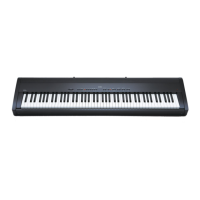Page
11
1
INTRODUCTION
z
EFFECTS
The EFFECTS function
adds chorus, delay,
tremolo, and rotary
speaker simulation effects
to the sound. (page 23)
z
REVERB
The REVERB function adds reverberation to the
sound, simulating the acoustic environment of a
recital room, stage, or concert hall. (page 22)
z
RECORDER
The RECORDER function
allows two track songs to be
recorded and stored to one of
the 4 different song memories,
and later played back or altered.
(page 29)
z
METRONOME
The METRONOME
function provides a steady
rhythm with which to aid
piano practice. The tempo,
time signature, and volume
of the metronome can be
freely adjusted. (page 27)
z
TOUCH
The TOUCH function allows
the touch sensitivity of the ES6
digital piano’s keyboard to be
adjusted. (page 25)
z
TRANSPOSE
The TRANSPOSE function
allows the audible pitch of
the ES6 digital piano to be
raised or lowered in half
steps. (page 26)
z
FUNCTION
The FUNCTION
mode allows various
advanced parameters
such as tuning,
temperament, MIDI
operation, and other
settings, to be adjusted.
(page 49)
z
LED DISPLAY
The LED display shows information
about selected sounds, functions, and
other important settings.
z
VALUE/BALANCE
The
S
and
T
VALUE/BALANCE
buttons are used to adjust
various settings and functions.
z
PHONES
The PHONES jacks located on the
left and right side of the ES6 digital
piano, are used to connect stereo
headphones to the instrument.
Two pairs of headphones can be
connected and used simultaneously.
z
POWER BUTTON
The POWER BUTTON is used to
turn the ES6 digital piano on and
off. Be sure to turn off the instrument
after playing. (page 13)
z
MIDI IN/OUT Connectors
Used to connect the ES6 digital piano to external MIDI devices
such as other electronic instruments or computers. (page 63)
z
USB Connector
Used to connect the ES6 digital piano with a personal
computer to exchange MIDI data. (page 74)
z
LINE IN STEREO Jack
Used to connect the stereo
output from other electronic
instruments or audio equipment
such as a CD player. (page 73)
z
LINE OUT Jacks
Used to connect the audio signal to an external amplifier,
speakers, or recording devices such as a computer. (page 73)
z
SPEAKER ON/OFF Switch
Used to turn the internal speakers on or off. (page 12)
z
DAMPER PEDAL Jack
Used to connect the included F-10H single pedal to the ES6
digital piano. (page 12)
z
DAMPER / SOFT PEDAL Jack
Used to connect the optional F-20 double pedal unit to
the ES6 digital piano. (page 12)
z
DC IN Jack
Used to connect the included PS-154 AC power adaptor. (page 73)
z
RHYTHM SECTION
The RHYTHM SECTION function
provides a selection of automatic
accompaniment styles, consisting of
drums, bass, and guitar parts. (page 37)
z
PA RT
The PART button is used to select
or mute recorded song parts, and
to adjust the RHYTHM SECTION
accompaniment.

